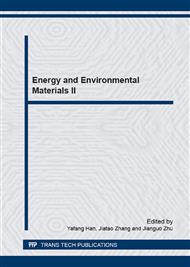[1]
M.N. Obrovac, L. Christensen, Structural changes in silicon anodes during lithium insertion/extraction. Electrochem Solid-State Lett, 7A (2004) 93-97.
DOI: 10.1149/1.1652421
Google Scholar
[2]
S. Bourderau, T. Brousse, D.M. Schleich, Amorphous silicon as a possible anode material for Li-ion batteries. J Power Sources. 81 (1999) 233-236.
DOI: 10.1016/s0378-7753(99)00194-9
Google Scholar
[3]
H. Li, X. Huang, L. Chen, Z. Wu, Y. Liang, A high capacity nano-Si composite anode material for lithium rechargeable batteries. Electrochem. Solid-State Lett. 2 (1999) 547—549.
DOI: 10.1149/1.1390899
Google Scholar
[4]
H. Ma, F. Cheng, J. Chen, J. Zhao, C. Li, . Z. Tao, J. Liang, Si/MgO composite anodes for Li-ion batteries. Adv. Mater. 19 (2007) 4067—4070.
Google Scholar
[5]
S.H. Ng, J. Wang, D. Wexler, K. Konstantinov, Z.P. Guo, H.K. Liu, Highly reversible lithium storage in spheroidal carbon-coated silicon nanocomposites as anodes for lithium-ion batteries. Angew. Chem. Int. Ed. 45 (2006) 6896—6899.
DOI: 10.1002/anie.200601676
Google Scholar
[6]
S.H. Ng, J Wang, D. Wexler, S.Y. Chew, H.K. Liu, A low-temperature synthesis via spray pyrolysis and their application as high-capacity anodes for lithium-ion batteries. J. Phys. Chem. C. 111 (2007) 11131—11138.
DOI: 10.1021/jp072778d
Google Scholar
[7]
M. Yoshio, H. Wang, K. Fukuda, T. Umeno, N. Dimov, Z.J. Ogumi, Carbon-coated Si as a lithium-ion battery anode material. Electrochem. Soc. 149 (2002) 1598—1603.
DOI: 10.1149/1.1518988
Google Scholar
[8]
M.H. Park, M.G. Kim, J. Joo, K. Kim, J. Kim, S. Ahn, Y. Cui, J. Cho, Silicon nanotube battery anodes. Nano Lett. 9 (2009) 3844—3847.
DOI: 10.1021/nl902058c
Google Scholar
[9]
H. Kim, B. Han, J. Choo, J. Cho, Three-dimensional porous silicon particles for use in high-performance lithium secondary batteries. Angew. Chem. Int. Ed. 47 (2008) 10151—10154.
DOI: 10.1002/anie.200804355
Google Scholar
[10]
X.D. Wu, Z.X. Wang, L.Q. Chen, Ag-enhanced SEI formation on Si particles for lithium batteries. Electrochemistry Communications. 5 (2003) 935—939.
DOI: 10.1016/j.elecom.2003.09.001
Google Scholar
[11]
Y.H. Xu, G.P. Yin, P.J. Zuo, Geometric and electronic studies of Li15Si4 for silicon anode. Electrochimica Acta. 54 (2008) 341-345.
DOI: 10.1016/j.electacta.2008.07.083
Google Scholar


